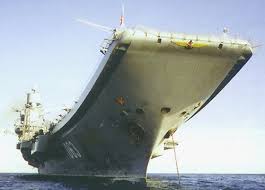
The Kiev class could never be considered true aircraft carriers. From the 1960s onwards, the rapidly expanding Soviet Navy began to see its lack of such a vessel to be a handicap, especially to a navy looking to spread its influence around the world. Several abortive projects were started, including the 1973 design for a nuclear-powered aircraft carrier of 85 000 tons which would be capable of accommodating 60 to 70 aircraft. In the early 1980s, two less ambitious projects began to make serious progress, the Project 1143.5 which was to become the Kuznetsov and the 75 000-ton Project 1143.7 which, had it been built, would have been the Ulyanovsk. This nuclear-powered ship with twin catapults was proposed to carry the upgraded Su-27KM and Yak-44 AEW/ASW fixed-wing aircraft within its complement of 60-70 aircraft.
Initially, Western analysts anticipated that the ships would have a combined nuclear and steam (CONAS) propulsion plant similar to the Kirov battle cruiser and the SSV-33 support/command ship. However the class was in fact conventionally propelled with oil-fired boilers.
Although superficially similar to American carriers, the 60 000-ton Soviet aircraft carrier was always intended to be subordinate to missile submarines operating in their bastions in the Arctic. It is capable of engaging surface, subsurface and airborne targets. The lack of catapults precludes launching aircraft with heavy strike loads, and the air superiority orientation of the air wing is apparent.
The flight deck area is 14 700 m² (158 235 sq ft) and aircraft take-off is assisted by a bow ski-jump angled at 12 degrees in lieu of steam catapults. The flight deck is equipped with arrester wires. Two starboard lifts carry the aircraft from the hangar to the flight deck. The ship was designed to operate Su-27K, MiG-29K, Yak-41 (and later the heavier and more capable Yak-43) supersonic STOVL fighters, but the only fixed wing aircraft regularly taken to sea have been the Su-27K (Su-33) and Su-25UTH, the latter being used as an unarmed trainer.
The first unit was originally named Riga. The name was changed to Leonid Brezhnev and then to Tbilisi before settling in October 1990 on Admiral Flota Sovetskogo Soyuza Kuznetsov, normally being shortened to Admiral Kuznetsov.
Construction of a sister ship (Project 1143.6, initially named Riga and later Varyag, the second of the class, started in December 1985 at Nikolayev, and the ship was launched in November 1988. Late in 1991 the Russian Defense Ministry stopped financing the carrier, and handed the hulk over to Ukraine. In 1998, the sale of the Varyag was announced - to a Macau-based entertainment company. The unfinished hull was to be towed to the Far East where it would be converted into an entertainment complex and casino. Though this company appeared to be a front for the Chinese Navy.





 მთავარი გვერდი
მთავარი გვერდი თამაშები
თამაშები



